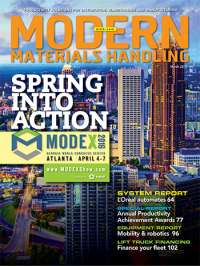60 seconds with John A. Caltagirone, Loyola University
John A. Caltagirone talks to Modern about best and better practices in the supply chain.
Latest Material Handling News
Registration open for Pack Expo International 2024 Walmart chooses Swisslog AS/RS and software for third milk processing facility NetLogistik partners with Vuzix subsidiary Moviynt to offer mobility solutions for warehouses Lucas Watson appointed CSO for Körber’s Parcel Logistics business in North America Hyster recognizes Dealers of Distinction for 2023 More NewsJohn A. Caltagirone
Title: Executive director, Supply and Value Chain Center, Quinlan School of Business, Loyola University in Chicago
Location: Chicago
Experience: 25 years in the industry including 15 years as a vice president and practice leader of supply chain. Three years at Loyola.
Duties: Caltagirone serves as the conduit between the business community, government, faculty and students at Loyola, while developing the center into a hub for supply chain and value chain creation in the Chicago Metropolitan Area.
Modern: Most practitioners think they need to adopt best practices in their warehousing and distribution processes, but you just wrote a piece for Supply Chain Management Review suggesting that instead, they should think about “better practices.” Tell us what you mean by better practices?
Caltagirone: When I first heard the term best practices about 18 years ago, I questioned why that was our focus. After all, what’s best for one company may not be best for another company. It also sounds as if once you’ve adopted a best practice, you’re done. There’s no need for continuous improvement. So, I started using the term better practices. To me, that means continuous improvement, and I think that’s what’s important. We need to always see if we can do better and raise the bar. You’ll never be perfect, but you can strive for that goal of continuous improvement.
Modern: You’ve spent many years in this field as an executive and now as the director of the center. How has the practice of supply chain management changed over your career?
Caltagirone: A number of things are different. Twenty years ago, our field was looked at as a necessary evil. A company had to have transportation, warehousing, logistics and inventory, but they were viewed as non-value adds. Today, C-level executives are beginning to recognize that their supply chains can be a game-changer in the marketplace. Even small companies are looking for customers on the other side of the world and developing global supply chain capabilities. We’re also seeing supply chains as integral to sustainability and social responsibility efforts. Companies like McDonald’s are traveling around the globe to meet the ranchers who raise the animals to make their products. At the same time, age-old problems like lean, Six Sigma, S&OP and inventory management just don’t go away. They will always be with us.
Modern: Is the level of talent changing as supply chains become more visible?
Caltagirone: Absolutely. Years ago, when I was coming up through the ranks, I remember a personnel manager asking me if I had room in the warehouse or transportation department for a mediocre employee. Today, we’re looking for sharp, experienced people who can think.
Modern: At ProMat, you were part of a roundtable group that looked at the talent crisis. How do you describe the talent crisis?
Caltagirone: First, there seems to be a shortage of talent across the supply chain, from drivers to demand planners to buyers and inventory managers. At the same time, there are only so many people graduating from supply chain programs and everyone is competing for them. And last is that the students coming out of the top schools are great at analytics, but have no interest in working in a distribution center. I recently had a class with 46 students. One day, I asked how many would prefer to work in a corporate center rather than a manufacturing plant or a DC. Forty five students raised their hands. They want to work in corporate centers in cities, and not in plants and DCs that tend to be in less populated areas. That’s a challenge for the industry.
Modern: Given the competition for talent at a program like Loyola’s, what is the one piece of advice you have for companies that are trying to address the talent challenges in their organizations? Is there a better practice?
Caltagirone: Build relationships with the career center and supply chain faculty in the schools that are of interest to you. When a member of our center tells me they need an intern, I recommend the best students I’ve had in class because I know them. Then, develop some kind of intern program where you can expose students to your business and almost guarantee them a job with your company. If you can get them as interns, that’s a win that you can turn into an employee.

Article Topics
Latest in Materials Handling
Registration open for Pack Expo International 2024 Walmart chooses Swisslog AS/RS and software for third milk processing facility NetLogistik partners with Vuzix subsidiary Moviynt to offer mobility solutions for warehouses Materials Handling Robotics: The new world of heterogeneous robotic integration BSLBATT is looking for new distributors and resellers worldwide Lucas Watson appointed CSO for Körber’s Parcel Logistics business in North America Hyster recognizes Dealers of Distinction for 2023 More Materials HandlingAbout the Author
Subscribe to Materials Handling Magazine

Find out what the world's most innovative companies are doing to improve productivity in their plants and distribution centers.
Start your FREE subscription today.
April 2024 Modern Materials Handling

Latest Resources











